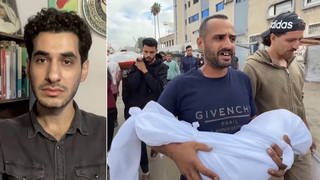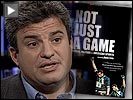
Guests
- Chris Nowinskiformer professional wrestler who has become a leading expert on sports-related head injuries. He is the author of Head Games: Football’s Concussion Crisis. He co-founded the Sports Legacy Institute. He is now co-director of the Center for the Study of Traumatic Encephalopathy.
Ahead of Sunday’s Super Bowl, the safety of football is coming under increasing scrutiny as more evidence emerges about links between concussions and brain damage. President Obama recently weighed in on the issue, saying, “If I had a son, I’d have to think long and hard before I let him play football.” We speak to former professional wrestler Chris Nowinski, co-founder of the Sports Legacy Institute and co-director of the Center for the Study of Traumatic Encephalopathy at Boston University School of Medicine, which maintains a bank of more than 140 athletes’ and military veterans’ brains in order to study the effects of concussions. He is the author of the book, “Head Games: Football’s Concussion Crisis,” which is the focus of a new documentary. [includes rush transcript]
Transcript
AMY GOODMAN: Queen, “We Will Rock You,” a song often played at football games. This is Democracy Now!, democracynow.org, The War and Peace Report. I’m Amy Goodman. As the San Francisco 49ers and Baltimore Ravens prepare for Sunday’s Super Bowl, the safety of football is coming under increasing scrutiny as more evidence emerges about links between concussions and brain damage. President Obama recently weighed in on the issue, saying, quote, “If I had a son, I’d have to think long and hard before I let him play football.”
Research shows repeated blows to the head can lead to chronic headaches, deteriorating memory, early dementia, and even premature death. Former football All-Pro Rodney Harrison revealed this week he’s now, quote, “scared to death,” after a career filled with concussions. He spoke with NBC’s Bob Costas.
RODNEY HARRIS: I would get up, hit someone. The entire stadium is spinning around. And I will walk to the sideline. They’ll hold me out for one play. They’ll give me two Advils, and they will tell me, “Get back into the game.” The NFL, if they are guilty of anything, it’s the lack of awareness that they brought and the lack of education that they told us. They never told us or explained to us or even let us know what a concussion was. I had no idea until just recently.
And even since I retired from the Patriots in 2008, I would still experience headaches. I would play on Sunday, and I would experience headaches up until Tuesday and Wednesday. And even now, at times, there’s a sense of loneliness, a sense of isolation, some anxiety problems. And sometimes I just—I get headaches. Like even being in bright lights, I get headaches. I’m out golfing. It’s tough.
And people have to understand that these players, yeah, a lot of their agendas, it’s based on money, but a lot of these players are really, really suffering, Bob. And this stuff is for real, because I’m experiencing it now. I’m scared to death. I have four kids, I have a beautiful wife. And I’m scared to death what may happen to me 10, 15 years from now.
AMY GOODMAN: Former NFL All-Pro Rodney Harrison. While concussions were once an unspoken and misunderstood problem, today more than 4,000 former NFL players have filed a lawsuit against the league. They contend the NFL, which makes $9.5 billion a year, knew hits to the head could lead to long-term brain damage but chose not disclose that information.
Meanwhile, new rules are being instituted to minimize future injuries. For example, a player can no longer lead with his helmet or hit a defenseless opponent.
For more, we’re going to New Orleans, just outside the Super Bowl, to speak with the author of the book on which that film was based. His name is Chris Nowinski, author of Head Games: Football’s Concussion Crisis. Chris is a former professional wrestler who’s become a leading expert on sports-related head injuries, also former football player at Harvard University. He co-founded the Sports Legacy Institute, now co-director of the Center for [the] Study of Traumatic Encephalopathy at Boston University School of Medicine, which maintains [an] ex-athletes’ brain bank to study the effects of concussions.
Chris Nowinski, welcome to Democracy Now! You’re at the Super Bowl, and you’re there to highlight something that is just really beginning to be talked about, as many players bring suit against the National Football League. Can you talk about brain injuries? Can you talk about what it means to have a concussion—what people are probably going to watch a lot of on Sunday?
CHRIS NOWINSKI: Sure. Yeah, I mean, I found out—I had the same experience as Rodney Harrison. I didn’t know I was getting concussions my entire career, until it was too late. When I was on the field, whether playing football or wrestling, I’d get hit in the head, and I would black out. I’d forget what I was doing, the sky would go orange, and I would just try to tough it off. And what we’ve learned through our research at Boston University is that, over time, that can trigger a degenerative brain disease that will eventually, you know, take away your memory, your—your ability to put together sentences, like right today. But in our last study we published in December, 34 of 35 former professional football players had this disease, nine of nine former college players, and even six high school players. So, we’re really concerned about the football—the last few generations of football players.
AMY GOODMAN: Now, the league has said for a long time, you know, the players can say, if they get hurt, they don’t want to go back in, that it’s their responsibility to say they’re injured.
CHRIS NOWINSKI: Yeah, that was—and Rodney hit it on the head. It was always a question of education. I did not know the definition of a concussion, even after having a Harvard degree and 19 years of bashing my head, because we’ve never forced anyone to ever tell an athlete what it means when you get hit in the head and things go fuzzy. And so, the idea—the problem was always informed consent at the beginning. And that’s why Ted Johnson, who was one of the first players to come forward, the former New England Patriot, stepped forward. He said, you know, “At least let me make this decision for myself.” And so, in 2010, the NFL finally did start educating the players. And so, now it’s a different ball game at the pro level, but what really needs to have a light shined on is the fact that there is no such thing as informed consent for children. And 95 percent of the people playing football in this country are under the age of consent, they’re under 18. And that’s where we really should be focusing.
AMY GOODMAN: Well, let’s talk—let’s talk about that for a minute. I bet there are a lot of moms and dads and kids who are listening right now. What about a family whose kid is just really good in football and in high school? Maybe they’re even being head-hunted right now for the big leagues. What do you say?
CHRIS NOWINSKI: I say it’s a huge risk right now. It’s—your child surviving youth football is right now mostly luck, because there are so few standards in place to actually protect them. Consider the fact that yesterday the NFL and NFLPA announced they will now have independent neurologists on the sideline because they do not trust the team doctors to make a judgment about whether or not someone who has a concussion can go back in. That’s the level of safety we have in the NFL. They even pay an athletic trainer to sit in the skybox to watch the television feed, because they miss so many concussions on the field. If that’s what these millionaires need to protect themselves—your child has no medical professionals, coaches with no training. You know, their young developing brain is more sensitive to the trauma. And so, from that perspective, you wonder how you could expose children to a game that we think is killing adults.
AMY GOODMAN: Chris Nowinski, can you talk about this unprecedented lawsuit that has been filed against the NFL?
CHRIS NOWINSKI: Yeah, I mean, personally, with our role, we kind of stay out of this. But from what’s been happening, is former players who did suffer these injuries on the job are suing the league for not warning them and then not taking care of them. You know, the reality is, you know, when I wrote the first edition of Head Games in 2006, I was appalled by the fact that, you know, chronic traumatic encephalopathy—this disease was originally called “punch drunk” in 1928. But we never looked into football, and everyone just assumed football would avoid it.
We knew that putting players back into the game was very bad for their brains when they had concussions, but we did it. You know, the 1937 American Football Coaches Association minutes talk about the fact that they’re saying, “We’ve got to stop putting guys back in. We’ve got to stop putting guys back in.” And it was 72 years later when that became the policy. So, you know, I don’t know what exactly happened, but, you know, there’s a lot of guys suffering that need care, and I understand why they’re suing.
AMY GOODMAN: I want to turn to an excerpt from the documentary Head Games, based on your book, Chris, by the same name.
ALAN SCHWARZ: It’s been known for a long time that banging your head over and over and over and over again can be a bad thing.
CHRIS NOWINSKI: And I remember I hit the ground, and I forgot where we were. I forgot what we were doing in the ring. I forgot what was coming next. I had been gladly exposing myself to repetitive brain trauma concussions for 19 years.
Members of the committee, this Friday night over a million kids will take to the football field. I am certain that radical measures are needed for football to continue safely.
REP. MAXINE WATERS: No matter what kind of helmet you build, it is a dangerous sport.
UNIDENTIFIED: Co-captain of the Penn football team committed suicide. He had 20 areas of his brain that were falling apart, that were all going to keep spreading.
ANNOUNCER: Whoa! Primeau got levelled!
KEITH PRIMEAU: I know that I damaged my brain. I don’t know where I am 10 years from now. I don’t know where I am 20 years from now.
CINDY PARLOW-CONE: After I had my first concussion, every time I would do heading, I would see stars.
GIRL SOCCER PLAYER: I was just like, “Oh, my god, my head hurts so bad.”
MOTHER 1: She didn’t pull herself out of the game. She didn’t tell the coach. And she didn’t tell us.
BOY HOCKEY PLAYER: I got hit from behind. People said I was on the ice for like four or five minutes. I only remember 20 seconds of it.
UNIDENTIFIED: That’s your brain. How much of you are you willing to put on the line for a game?
BOB COSTAS: But what’s the level of acceptableness? And what is the level of reasonable reform?
CHRIS NOWINSKI: If you only have one out of every hundred kids getting diagnosed with a concussion, you’re missing them, and your kids are at terrible risk.
MOTHER 2: I might look back and say I wished I had stopped him after this last concussion. He loved to play hockey, and we loved watching him play hockey.
MOTHER 3: I believe you just have to protect them as much as you can and—and pray.
AMY GOODMAN: An excerpt of Head Games, based on our guest Chris Nowinski’s book by the same title. Chris, journalist Paul Barrett has a new article out in Businessweek called “Will Brain Injury Lawsuits Doom or Save the NFL?” In it, he writes, quote, “New research suggests the peril players face may not be limited to car wreck hits. It may extend to the relentless, day-in-and-day-out collisions that are the essence of the game. If science one day determines [that] merely playing serious tackle football substantially increases the danger of debilitating brain disease—as smoking cigarettes makes lung cancer much more likely—it’s conceivable [that] the NFL could go the way of professional boxing.” Chris Nowinski, what’s your response?
CHRIS NOWINSKI: I think that’s an accurate portrayal of the situation. You know, football has a very short window to reform itself, especially at the youth level, so that we can feel comfortable exposing kids to this game. You know, pretty soon we’re going to be able to diagnose CTE in living people. And the day we do that, and the day we scan a high school football team, and if we find 10, 20, 30 percent of kids with this degenerative brain disease before the age of 18, I think, you know, the games will have a very, very short future after that. So, you know, football needs to reform, and reform quickly.
Today we’re going to be actually doing a press conference talking about the fact that the only place that—one of the only places that doesn’t set any limits to how frequently and how many days you can hit each other is high school football. For example, in the state of Illinois where I played high school football, we weren’t allowed to hit in the summer. Now, Illinois has 20 days of summer contact. It’s kind of bizarre.
AMY GOODMAN: Chris, a lot of people have learned about this through the suicides of football players. And one of those football players who actually shot himself, but instead of shooting himself in the head, shot himself in the chest, because he wanted his—he wanted to donate his brain to science to study.
CHRIS NOWINSKI: Yeah, Dave Duerson, a former Chicago Bear. I actually grew up in Chicago, so I grew up watching him. And he actually gave me a scholarship when I was 17, from the National Football Foundation. He, you know, was one of the most successful guys post-NFL career, was on the board of trustees at Notre Dame, ran a multimillion-dollar food distribution. At 45, started having problems with headaches, memory issues, and especially impulse control—got violent with his family, got violent with his children. His wife divorced him. He ended up $20 million in debt. And, you know, left a note asking for us to study his brain, so, I think—so that we could show it wasn’t him, the Dave Duerson we all knew, that did all those terrible things. And it wasn’t. He had an advanced case of CTE. It was very tragic.
AMY GOODMAN: Again, CTE, chronic traumatic encephalopathy. Chris Nowinski, your Sports Legacy Institute and your work at Boston University now, you are—you have the brains of various football players? You are collecting this as evidence?
CHRIS NOWINSKI: Right, because, you know, there never was a center in the world dedicated to this disease. And the beginning of the study of any disease has to start with knowing what you’re dealing with. And so we started this brain bank in 2008. We now have the brains of over 140 athletes, over 100 of which have turned up positive for this disease—not just football players: ice hockey players, rugby players, boxing, professional wrestling, and some more sports that we’re going to introduce this year. And it’s not just even just athletes: military veterans, battered spouses, epileptics with dozens of falls. So it’s—you know, this is a disease that we didn’t pay attention to, we didn’t understand, and now we really have to catch up and confront.
AMY GOODMAN: Chris Nowinski, I want to thank you so much for being with us and for your work. He’s a former Harvard football player, former professional wrestler, leading expert on sports-related head injuries, author of Head Games: Football’s Concussion Crisis, now co-founded the Sports Legacy Institute.












Media Options